Attached files
| file | filename |
|---|---|
| 8-K - 8-K - California Resources Corp | form8-ktudorpickeringholtc.htm |
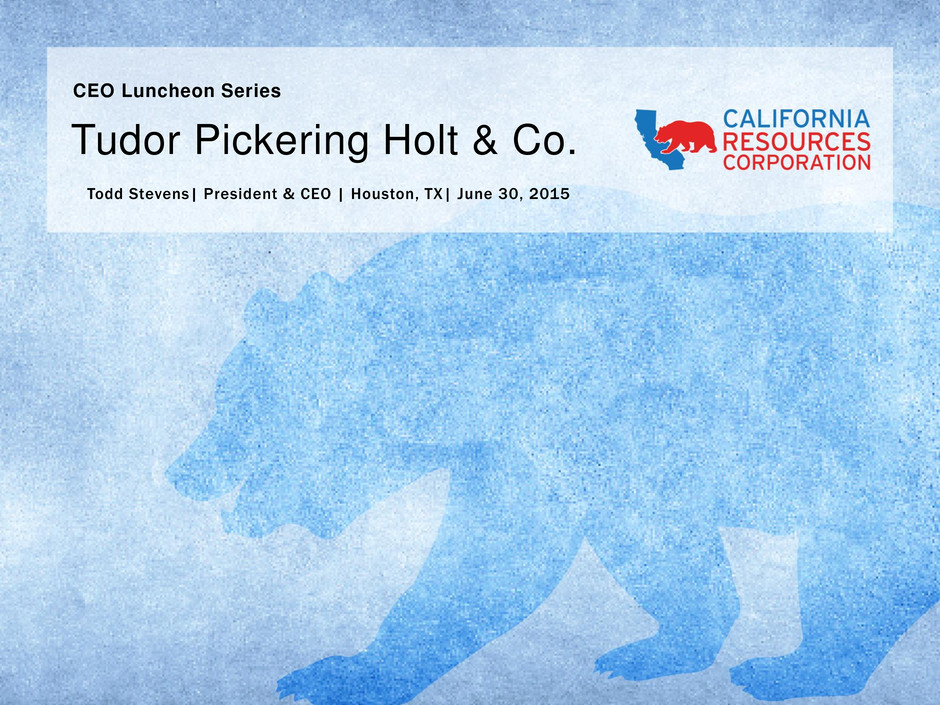
Tudor Pickering Holt & Co. Todd Stevens| President & CEO | Houston, TX| June 30, 2015 CEO Luncheon Series
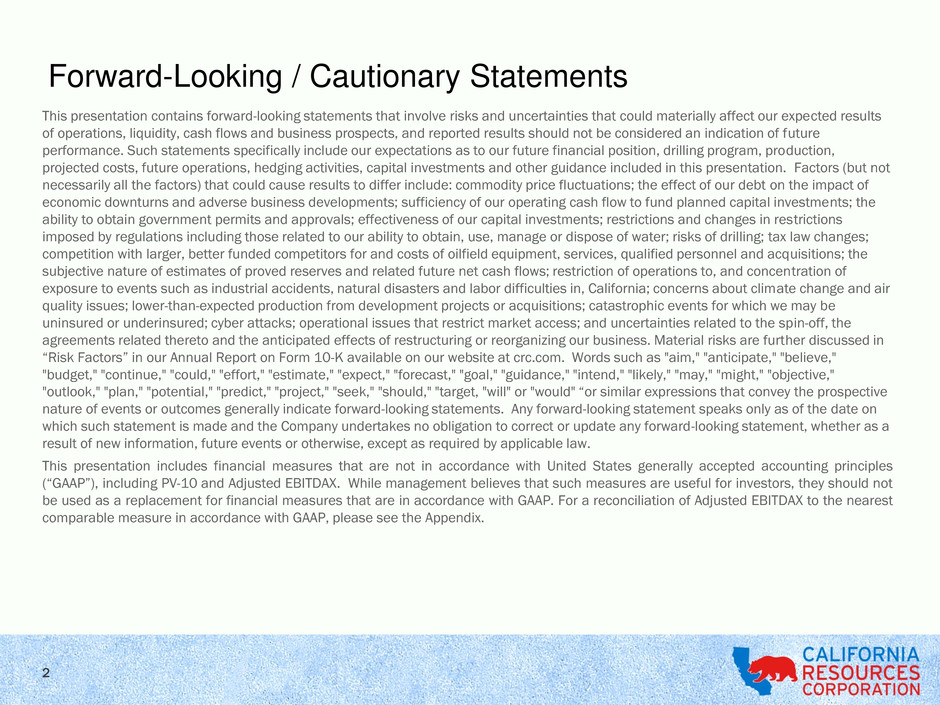
Forward-Looking / Cautionary Statements This presentation contains forward-looking statements that involve risks and uncertainties that could materially affect our expected results of operations, liquidity, cash flows and business prospects, and reported results should not be considered an indication of future performance. Such statements specifically include our expectations as to our future financial position, drilling program, production, projected costs, future operations, hedging activities, capital investments and other guidance included in this presentation. Factors (but not necessarily all the factors) that could cause results to differ include: commodity price fluctuations; the effect of our debt on the impact of economic downturns and adverse business developments; sufficiency of our operating cash flow to fund planned capital investments; the ability to obtain government permits and approvals; effectiveness of our capital investments; restrictions and changes in restrictions imposed by regulations including those related to our ability to obtain, use, manage or dispose of water; risks of drilling; tax law changes; competition with larger, better funded competitors for and costs of oilfield equipment, services, qualified personnel and acquisitions; the subjective nature of estimates of proved reserves and related future net cash flows; restriction of operations to, and concentration of exposure to events such as industrial accidents, natural disasters and labor difficulties in, California; concerns about climate change and air quality issues; lower-than-expected production from development projects or acquisitions; catastrophic events for which we may be uninsured or underinsured; cyber attacks; operational issues that restrict market access; and uncertainties related to the spin-off, the agreements related thereto and the anticipated effects of restructuring or reorganizing our business. Material risks are further discussed in “Risk Factors” in our Annual Report on Form 10-K available on our website at crc.com. Words such as "aim," "anticipate," "believe," "budget," "continue," "could," "effort," "estimate," "expect," "forecast," "goal," "guidance," "intend," "likely," "may," "might," "objective," "outlook," "plan," "potential," "predict," "project," "seek," "should," "target, "will" or "would" “or similar expressions that convey the prospective nature of events or outcomes generally indicate forward-looking statements. Any forward-looking statement speaks only as of the date on which such statement is made and the Company undertakes no obligation to correct or update any forward-looking statement, whether as a result of new information, future events or otherwise, except as required by applicable law. This presentation includes financial measures that are not in accordance with United States generally accepted accounting principles (“GAAP”), including PV-10 and Adjusted EBITDAX. While management believes that such measures are useful for investors, they should not be used as a replacement for financial measures that are in accordance with GAAP. For a reconciliation of Adjusted EBITDAX to the nearest comparable measure in accordance with GAAP, please see the Appendix. 2

Cautionary Statements Regarding Hydrocarbon Quantities We have provided internally generated estimates for proved reserves and aggregated proved, probable and possible reserves (“3P Reserves”) as of December 31, 2014 in this presentation, with each category of reserves estimated in accordance with SEC guidelines and definitions, though we have not reported all such estimates to the SEC. As used in this presentation: • Probable reserves. We use deterministic methods to estimate probable reserve quantities, and when deterministic methods are used, it is as likely as not that actual remaining quantities recovered will exceed the sum of estimated proved plus probable reserves. • Possible reserves. We use deterministic methods to estimate possible reserve quantities, and when deterministic methods are used to estimate possible reserve quantities, the total quantities ultimately recovered from a project have a low probability of exceeding proved plus probable plus possible reserves. The SEC prohibits companies from aggregating proved, probable and possible reserves estimated using deterministic estimation methods in filings with the SEC due to the different levels of certainty associated with each reserve category. Actual quantities that may be ultimately recovered from our interests may differ substantially from the estimates in this presentation. Factors affecting ultimate recovery include the scope of our ongoing drilling program, which will be directly affected by commodity prices, the availability of capital, regulatory approvals, drilling and production costs, availability of drilling services and equipment, drilling results, lease expirations, transportation constraints and other factors; actual drilling results, which may be affected by geological, mechanical and other factors that determine recovery rates; and budgets based upon our future evaluation of risk, returns and the availability of capital. In this presentation, we may use the term “oil-in-place” or other descriptions of resource potential which the SEC guidelines restrict us from including in filings with the SEC. These have been estimated internally without review by independent engineers and may include shale resources which are not considered in most older, publicly available estimates. We use the term “oil-in-place”, “net unrisked 3P resources”, “net unrisked prospective resources” and “estimated ultimate recovery” in this presentation to describe estimates of potentially recoverable hydrocarbons remaining in the applicable reservoir. Actual recovery of these potential resource volumes is inherently more speculative than recovery of estimated reserves and any such recovery will be dependent upon future design and implementation of a successful development plan. Management’s estimate of original hydrocarbons in place includes historical production plus estimates of proved, probable and possible reserves and a gross resource estimate that has not been reduced by appropriate factors for potential recovery and as a result differs significantly from estimates of hydrocarbons that can potentially be recovered. Ultimate recoveries will be dependent upon numerous factors including those noted above. 3

NY00813G / 589203_1.WOR Sacramento Basin 19 MMBoe Proved Reserves 9 MBoe/d production San Joaquin Basin 525 MMBoe Proved Reserves 112 MBoe/d production Ventura Basin 58 MMBoe Proved Reserves 9 MBoe/d production Los Angeles Basin 166 MMBoe Proved Reserves 29 MBoe/d production • World-Class Resource Base In 4 of 12 largest fields in the continental U.S. 768 MMBoe proved reserves • Capital Structure No significant near-term debt maturities, liquidity events Reviewing options to reduce spin-off debt Adjusted 2015 capital investment plan to $440mm, down 80% from 2014 level • Positioned to Grow as Prices Normalize Internally funded capital program designed to live within cash flow and drive growth • 203% organic proved reserve replacement* • Organic F&D cost of $17.68/boe* • >17,000 potential net drilling locations* Operating flexibility to shift basins and drive mechanisms to optimize growth through commodity price cycles CRC at a Glance Reserves as of 12/31/14; Production figures reflect average 2014 rates * All calculations are based on 2014 data. Refer to Appendix for more information. . 4

Overview of California Resources Corporation California Pure-Play Net Resource Overview • An independent E&P company spun off by Occidental • Focused on high-return assets in California • Largest private mineral acreage-holder, with 2.4 million net acres1 • ~60% of total net mineral interests position held in fee1 • Conventional and unconventional opportunities • Primary production • Waterfloods & gas injection • Steam / EOR • Substantial base of Proved Reserves1 • 768 MMBoe (72% PD, 72% oil, 83% liquids) • PV-10 of $16.1 billion (SEC 5 year rule applied to PUDs)* Avg. net production by basin (12/31/2014) San Joaquin Basin 68% 70% PD Los Angeles Basin 22% 76% PD Ventura Basin 8% 72% PD Sacramento Basin 2% 94% PD San Joaquin Basin 70% 57% Oil Los Angeles Basin 18% 100% Oil Ventura Basin 6% 69% Oil Sacramento Basin 6% 1 As of 12/31/2014 219,800 gross locations in known formations as of 12/31/14. Does not include 6,400 prospective resource locations. *See Appendix for more information. Total proved reserves by basin (12/31/2014) 14,450 73% 2,000 10% 2,350 12% 1,000 5% San Joaquin Basin Los Angeles Basin Sacramento Basin Ventura Basin Total identified gross drilling locations by basin2 19,800 total gross locations2768 MMBoe, 72% PD, 72% oil 159 MBoe/d, 63% oil 5

Focus on Oil Enhances Base & Margins 1Q14 2Q14 3Q14 4Q14 1Q15 2Q15E FY 2014 FY 2015E Production By Stream (MBoe/d) Oil NGL Gas Guidance Range Average Total Production 159 Mboe/d Average Oil Production 99 MBbl/d Resource base enables predictable production profile • Conventional assets have relatively low decline rates, long production life • Steamflood and waterflood investments will deliver crude oil growth in 2015 with little new investment • Large inventory of conventional development projects that are expected to be repeatable, with low technical risk Application of modern technologies produces growth opportunity in California • Deferring many high-return project opportunities until prices rise • Identifying investments economically viable through commodity price cycles 6
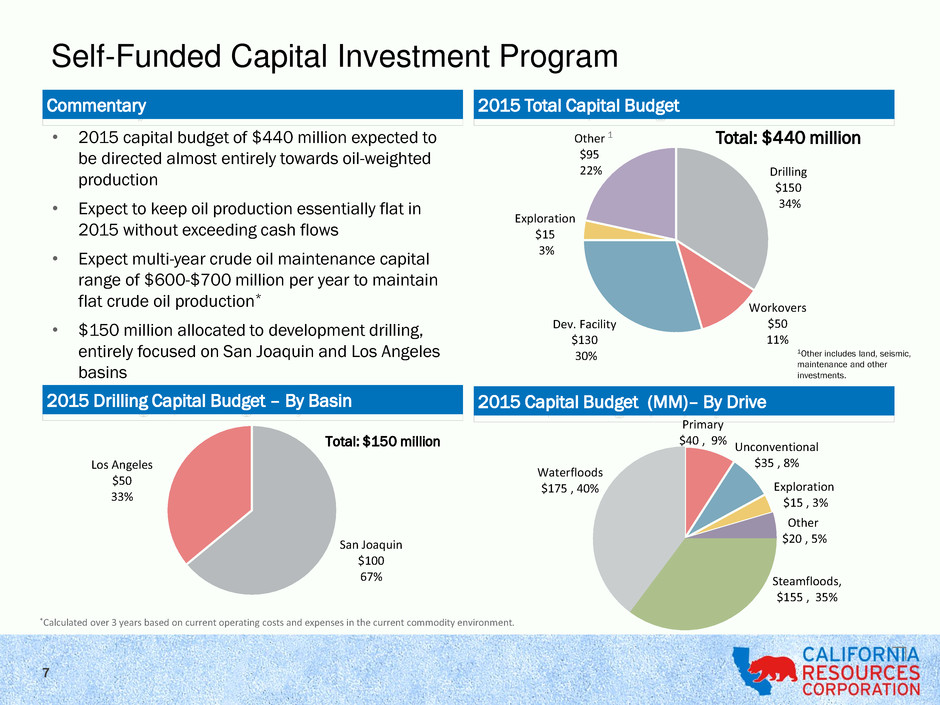
Drilling $150 34% Dev. Facility $130 30% Workovers $50 11% Exploration $15 3% Other $95 22% Commentary 2015 Drilling Capital Budget – By Basin 2015 Total Capital Budget 2015 Capital Budget (MM)– By Drive San Joaquin $100 67% Los Angeles $50 33% • 2015 capital budget of $440 million expected to be directed almost entirely towards oil-weighted production • Expect to keep oil production essentially flat in 2015 without exceeding cash flows • Expect multi-year crude oil maintenance capital range of $600-$700 million per year to maintain flat crude oil production* • $150 million allocated to development drilling, entirely focused on San Joaquin and Los Angeles basins Total: $440 million Total: $150 million Primary $40 , 9% Unconventional $35 , 8% Exploration $15 , 3% Other $20 , 5% Steamfloods, $155 , 35% Waterfloods $175 , 40% 1Other includes land, seismic, maintenance and other investments. 1 Self-Funded Capital Investment Program 7 *Calculated over 3 years based on current operating costs and expenses in the current commodity environment.

• Exploring adjustments to capital structure Total long-term debt: ~$6.5 billion, net, at 3/31/2015 Have received an amendment to revolver and term loan through end of 2016 Resource base enables a variety of alternatives, e.g. asset monetizations, JVs, MLPs and other opportunities, all subject to indenture, loan and spin-off related tax sharing agreement restrictions Given the long time horizon and growth potential of the company’s asset base, management is conducting a thoughtful assessment of the various midstream and upstream alternatives to enhance shareholder value • Our model for internally funded capital budgets Capital budget is internally funded and lives within free cash flow after debt service Select projects on the basis of potential future value creation (VCI)1 Target expected value creation of 30% per invested dollar using VCI metric Maintain significant operational flexibility to adjust production Capital Allocation Priority: De-Leveraging Balance Sheet 1 The VCI for each project is calculated by dividing the net present value of the project's expected pre-tax cash flow over its life by the present value of the investments, each using a 10% discount rate. Projects are expected to meet a VCI of 1.3, meaning that 30% of expected value is created for every dollar invested. 8
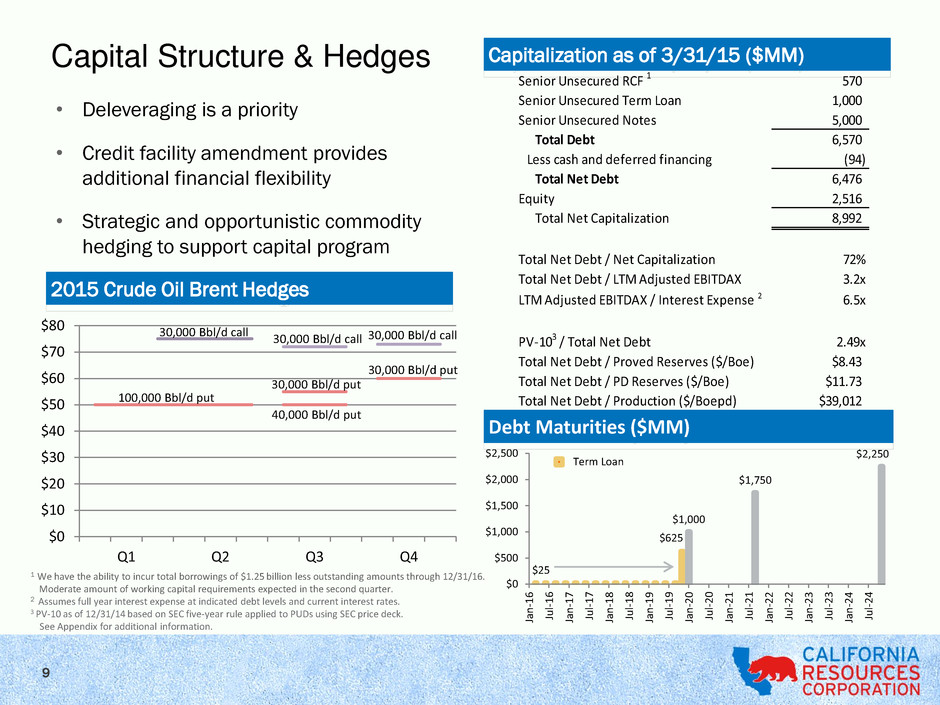
• Deleveraging is a priority • Credit facility amendment provides additional financial flexibility • Strategic and opportunistic commodity hedging to support capital program Capitalization as of 3/31/15 ($MM) $25 $625 $1,000 $1,750 $2,250 $0 $500 $1,000 $1,500 $2,000 $2,500 Ja n -1 6 Ju l-1 6 Ja n -1 7 Ju l-1 7 Ja n -1 8 Ju l-1 8 Ja n -1 9 Ju l-1 9 Ja n -2 0 Ju l-2 0 Ja n -2 1 Ju l-2 1 Ja n -2 2 Ju l-2 2 Ja n -2 3 Ju l-2 3 Ja n -2 4 Ju l-2 4 Term Loan Debt Maturities ($MM) Capital Structure & Hedges 2015 Crude Oil Brent Hedges $0 $10 $20 $30 $40 $50 $60 $70 $80 Q1 Q2 Q3 Q4 100,000 Bbl/d put 40,000 Bbl/d put 30,000 Bbl/d call 30,000 Bbl/d put 30,000 Bbl/d call Senior Unsecured RCF 1 570 Senior Unsecured Term Loan 1,000 Senior Unsecured Notes 5,000 Total Debt 6,570 Less cash and deferred financing (94) Total Net Debt 6,476 Equity 2,516 Total Net Capitalization 8,992 Total Net Debt / Net Capitalization 72% Total Net Debt / LTM Adjusted EBITDAX 3.2x LTM Adjusted EBITDAX / Interest Expense 2 6.5x PV-103 / Total Net Debt 2.49x Total Net Debt / Proved Reserves ($/Boe) $8.43 Total Net Debt / PD Reserves ($/Boe) $11.73 Total Net Debt / Production ($/Boepd) $39,012 1 We have the ability to incur total borrowings of $1.25 billion less outstanding amounts through 12/31/16. Moderate amount of working capital requirements expected in the second quarter. 2 Assumes full year interest expense at indicated debt levels and current interest rates. 3 PV-10 as of 12/31/14 based on SEC five-year rule applied to PUDs using SEC price deck. See Appendix for additional information. 30,000 Bbl/d call 30,000 Bbl/d put 9

Long Term Value Creation Driven by World Class Asset Base 10

NY00813G / 589203_1.WOR 0 50 100 150 200 250 300 G ro ss O p era te d MB o e/ d Top California Producers in 2014* Growth of Top California Producers 195 159 139 37 35 - 20 40 60 80 100 120 140 160 180 200 CRC CVX Aera Energy FCX LINE G ro ss O p era te d MB o e/ d Aera Chevron CRC *Gross operated production from DOGGR. CRC is the Leading Operator in California 11

As of 12/31/2014 Net Proved Reserves (MMBoe) 768 % Oil– Net Proved 72% Pre-Tax Proved PV-10 ($ millions)1 $16,091 2014 Avg. Net Production (MBoe/d) 159 % Oil 63% Net Acreage (‘000 acres) 2,400 Identified Gross Locations 19,800 1 PV-10 shown as of 12/31/14 based on SEC five-year rule applied to PUDs using SEC-based realized price deck of $95.20/Bbl and $4.73/Mcf. See Appendix for additional information. San Joaquin Basin Los Angeles Basin Ventura Basin Sacramento Basin 2014 Net Proved Reserves (MMBoe) 525 166 58 19 % Liquids – Net Proved 80% 98% 88% 0% 2014 Avg. Net Production (MBoe/d) 112 29 9 9 % Oil 57% 100% 69% 0% 2014 Net Acreage (million acres) 1.6 <0.1 0.3 0.5 Identified Gross Drilling Locations 14,450 2,000 2,350 1,000 World Class Assets with Significant Development Opportunities • Diversity of basins, drive mechanisms. • Predictable production, low decline rates. • Multi-stacked reservoirs. • Development targets include repeatable projects with low technical risk. 12
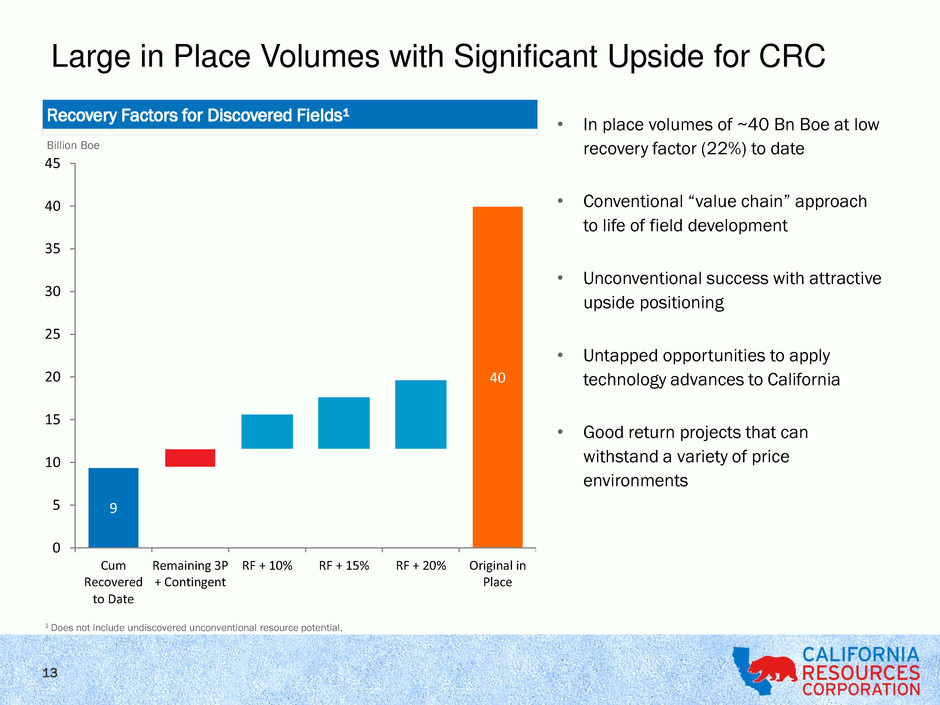
Recovery Factors for Discovered Fields¹ 9 40 0 5 10 15 20 25 30 35 40 45 Cum Recovered to Date Remaining 3P + Contingent RF + 10% RF + 15% RF + 20% Original in Place Billion Boe 1 Does not include undiscovered unconventional resource potential. • In place volumes of ~40 Bn Boe at low recovery factor (22%) to date • Conventional “value chain” approach to life of field development • Unconventional success with attractive upside positioning • Untapped opportunities to apply technology advances to California • Good return projects that can withstand a variety of price environments Large in Place Volumes with Significant Upside for CRC 13
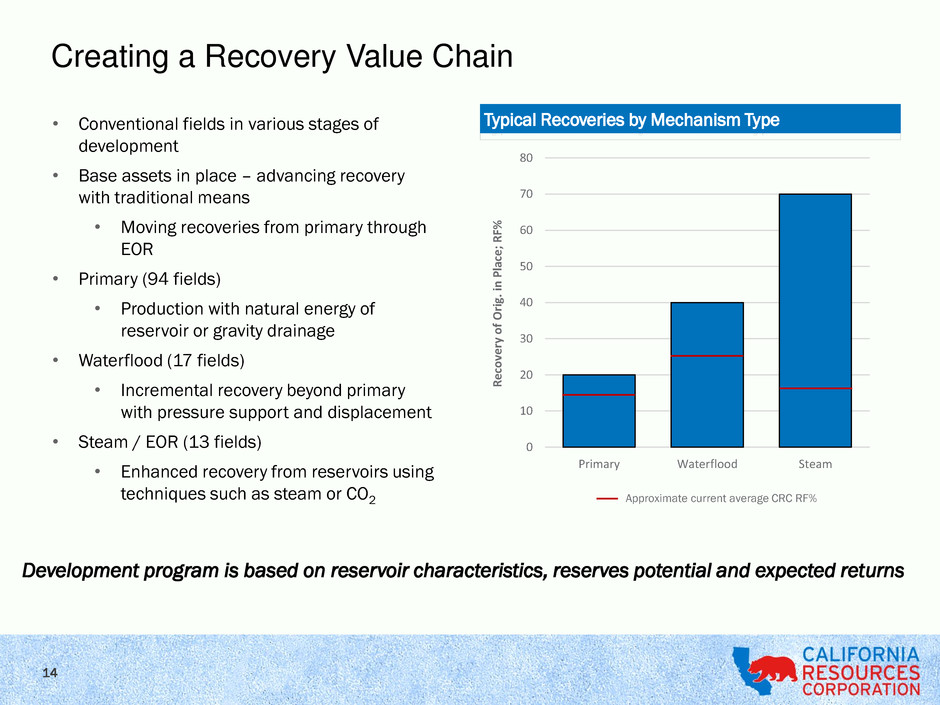
• Conventional fields in various stages of development • Base assets in place – advancing recovery with traditional means • Moving recoveries from primary through EOR • Primary (94 fields) • Production with natural energy of reservoir or gravity drainage • Waterflood (17 fields) • Incremental recovery beyond primary with pressure support and displacement • Steam / EOR (13 fields) • Enhanced recovery from reservoirs using techniques such as steam or CO2 0 10 20 30 40 50 60 70 80 Primary Waterflood Steam R e co ve ry o f O ri g. in P la ce ; R F% Approximate current average CRC RF% Development program is based on reservoir characteristics, reserves potential and expected returns Typical Recoveries by Mechanism Type Creating a Recovery Value Chain 14

15 2014 Exploration Portfolio Prospective Shale Plays San Joaquin Conventional San Joaquin Unconventional Sacramento Basin Conventional Ventura Basin Conventional Lower Monterey Kreyenhagen Moreno 2.0 Bn Boe Net Unrisked Prospective Resources San Joaquin Conventional San Joaquin Unconventional Sacramento Basin Conventional Ventura Basin Conventional 1.5 Bn Boe Net Unrisked Resources 5,117 Net Drilling Locations Lower Monterey Kreyenhagen Moreno 5,300 Net Drilling Locations Near Field Exploration in Proven Play Trends

$95.12 $94.21 $97.97 $93.00 $48.63 $103.80 $104.02 $104.16 $92.30 $46.44 $110.90 $111.70 $108.76 $99.51 $55.17 $30 $40 $50 $60 $70 $80 $90 $100 $110 $120 2011 2012 2013 2014 1Q15 $ /B b l WTI Realizations Brent $4.11 $2.81 $3.66 $4.39 $3.06 $4.31 $2.94 $3.73 $4.34 $2.84 0.0 0.5 1.0 1.5 2.0 2.5 3.0 3.5 4.0 4.5 5.0 2011 2012 2013 2014 1Q15 $ /M cf NYMEX Realizations NGL Price Realization - % of WTI Realization % of WTI 109% 110% 106 % 99% 95% Realization % of NYMEX 105% 105 % 102 % 101% 93% Oil Price Realization Gas Price Realization 74% 56% 51% 51% 44% 0% 10% 20% 30% 40% 50% 60% 70% 80% 2011 2012 2013 2014 1Q15 % o f WT I CRC – Price Realizations • Since California imports a significant percentage of its crude oil requirements, California refiners typically purchase crude oil at international index-based prices for comparable grades • California also imports approximately 90% of its natural gas • Discrete California market issues, including refinery strikes, have impacted differentials 16
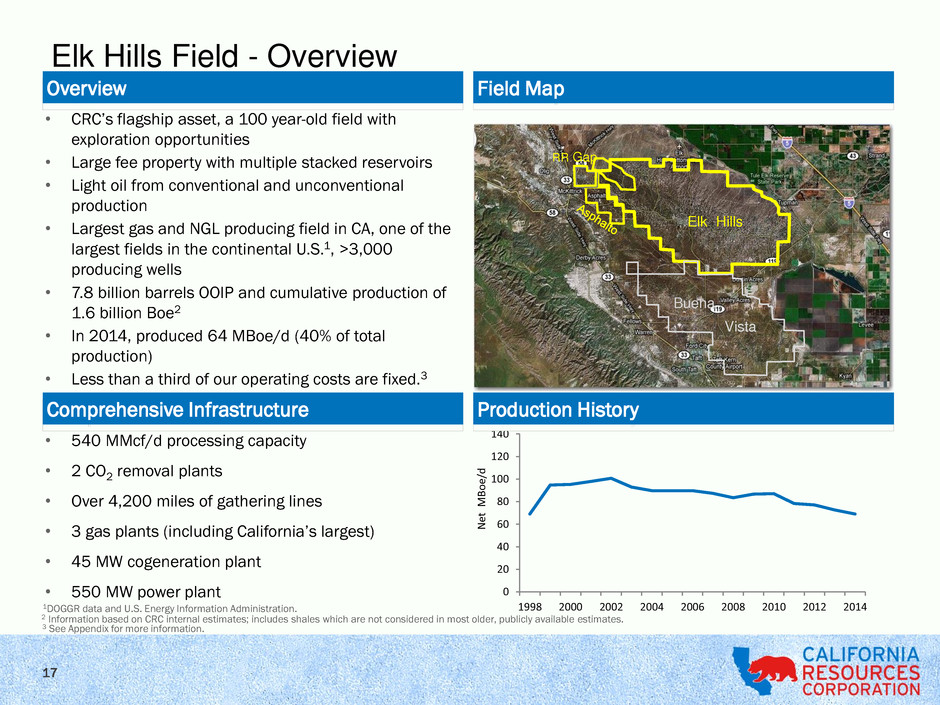
0 20 40 60 80 100 120 140 1998 2000 2002 2004 2006 2008 2010 2012 2014 N et MB o e/ d • CRC’s flagship asset, a 100 year-old field with exploration opportunities • Large fee property with multiple stacked reservoirs • Light oil from conventional and unconventional production • Largest gas and NGL producing field in CA, one of the largest fields in the continental U.S.1, >3,000 producing wells • 7.8 billion barrels OOIP and cumulative production of 1.6 billion Boe2 • In 2014, produced 64 MBoe/d (40% of total production) • Less than a third of our operating costs are fixed.3 • 540 MMcf/d processing capacity • 2 CO2 removal plants • Over 4,200 miles of gathering lines • 3 gas plants (including California’s largest) • 45 MW cogeneration plant • 550 MW power plant Overview Comprehensive Infrastructure Field Map Production History 1DOGGR data and U.S. Energy Information Administration. Elk Hills Buena Vista RR Gap Elk Hills Field - Overview 2 Information based on CRC internal estimates; includes shales which are not considered in most older, publicly available estimates. 17 3 See Appendix for more information.

18 Effective Management of Elk Hills Field Operating Costs* *Transition from primary to secondary production in Elk Hills has been occurring during this period. The Wilmington Field has similarly experienced declines in Opex per well and Opex per Boe despite a significantly higher WOR (~39 in 2014). 10.0 10.5 11.0 11.5 12.0 12.5 13.0 13.5 14.0 14.5 15.0 2012 2014 2015Q1 W ater - Oil R ati o (W O R ) Elk Hills Field Water-Oil Ratio (WOR) 136,000 94,000 69,000 - 20,000 40,000 60,000 80,000 100,000 120,000 140,000 160,000 2012 2014 2015Q1 O p er ati n g Co st / W ell, $/ w el l Elk Hills Field - Opex per Well $16.46 $14.31 $11.10 2,000 2,500 3,000 3,500 4,000 4,500 5,000 $- $2.00 $4.00 $6.00 $8.00 $10.00 $12.00 $14.00 $16.00 $18.00 2012 2014 2015Q1 O p er ati n g Co st , $/ b o e Elk Hills Field - Opex, $/boe Opex, $/boe Well Counts W ell Co u n ts

CRC Corporate LOE Costs Managed Down 19 $0 $5 $10 $15 $20 $25 2011 2012 2013 2014 Steam Injectant Gas Plant Expense Energy Supports Downhole Maintenance Workovers / Well Enhancement Surface Operation and Maintenance $ /Bo e

- 50 100 150 200 250 2000 2001 2002 2003 2004 2005 2006 2007 2008 2009 2010 2011 2012 2013 2014 M M B o e Net Proved Reserves Production to Date Overview Field Map Proved Reserves & Cumulative Production Structure Map & Acquisition History * • CRC’s flagship coastal asset: acquired in 2000 • Field discovered in 1932; 3rd largest field in the U.S. • Over 7 billion barrels OOIP (34% recovered to date)1 • Depths 2,000’ – 10,000’ (TVDSS) • 2014 avg. production of 36.0 MBoe/d (gross) • Over 8,000 wells drilled to date • Less than a third of our operating costs are fixed2 • PSC (Working Interest and NRI vary by contract) • CRC partnering with State and City of Long Beach *Proved reserves prior to 2009 represent previously effective SEC methodology. Proved reserves for 2009 – 2014 are based on current SEC reserve methodology and SEC pricing. 1 Information based on CRC internal estimates; includes shales which are not considered in most older, publicly available estimates. Tidelands Acquired: 2006 Belmont Offshore Acquired: 2003 Long Beach Unit Acquired: 2000 Pico Properties Acquired: 2008 Wilmington Field - Overview 20 2 See Appendix for more information.

0 50 100 150 200 250 300 350 400 450 500 0 500 1,000 1,500 2,000 2,500 3,000 3,500 4,000 4,500 5,000 1 9 9 5 1 9 9 6 1 9 9 7 1 9 9 9 2 0 0 0 2 0 0 1 2 0 0 3 2 0 0 4 2 0 0 5 2 0 0 7 2 0 0 8 2 0 0 9 2 0 1 1 2 0 1 2 2 0 1 3 2 0 1 5 # o f W el ls B O P D BOPD Well Count Ownership by Other Companies ROR Sensitivity Conventional Waterflood Example Type Curve Economics @ $70 2015 Average Pattern cost ($MM) $0.45 % Oil 100% VCI 4.4 Payback (years) 1.1 Net 2014 F&D ($ / Boe)1 $6.30 • Field discovered in 1920s by a major oil company • Multiple stacked zones 1,200’ – 2,000’ • 150 MMBoe in place at 6% RF • Acquired property in 2009 • Geologic re-characterization and modeling • Applying modern technologies • Producing 2,700 Bopd (100% oil) as of Q4’14 • 200 potential locations CRC Acquired Mount Poso Red outline indicates base case for type curve economics at average field NRI. 1 Refer to Appendix for detail on the calculation of F&D costs. EUR (Gross) MBoe O il P ri ce s (B ren t $ / B b l) risk 43 65 87 109 131 $80 76% 126% 178% 231% 287% $70 62% 105% 149% 194% 241% $60 48% 84% 120% 157% 195% EUR – Estimated Ultimate Recovery. 21

Conventional Steamflood Example • Eastern San Joaquin Valley Steamflood • Two major intervals 1,500’ – 2,500’ • 500 MMBoe in place at 35% RF • Field extension • Geologic re-characterization • Facilities expansion in 2013 • Production grew 35% in 2014 • 50% growth in steam generation • 800+ potential locations (~110 patterns) EUR (Gross) MBoe Oi l P ri ce s (B re n t $ / B b l) 140 160 180 200 220 $80 42% 51% 60% 69% 77% $70 32% 40% 47% 54% 62% $60 21% 28% 34% 40% 46% 7 Spot Inv 2015 Pattern cost ($MM) $1.4 % Oil 100% VCI 2.9 Payback (years) 2.2 Net 2014 F&D ($ / Boe)1 $9.00 ROR Sensitivity Type Curve Economics @ $70 Year over Year Performance EUR – Estimated Ultimate Recovery. Red outline indicates base case for type curve economics. 1 Refer to Appendix for detail on the calculation of F&D costs. 40,000 50,000 60,000 70,000 80,000 90,000 100,000 110,000 6,000 7,000 8,000 9,000 10,000 11,000 12,000 13,000 14,000 15,000 Ja n -1 3 Fe b -1 3 Ma r-1 3 A p r-1 3 May-1 3 Ju n -1 3 Ju l-1 3 A u g-1 3 Se p -1 3 O ct -1 3 N o v-1 3 D ec -1 3 Ja n -1 4 Fe b -1 4 Ma r-1 4 A p r-1 4 May-1 4 Ju n -1 4 Ju l-1 4 A u g-1 4 Se p -1 4 O ct -1 4 N o v-1 4 D ec -1 4 B SP D B OP D Net Oil (bopd) Steam (bspd) 2013 2014 2013 Avg 8,400 bopd 62,000 bspd 2014 Avg 11,300 bopd 93,000 bspd 22
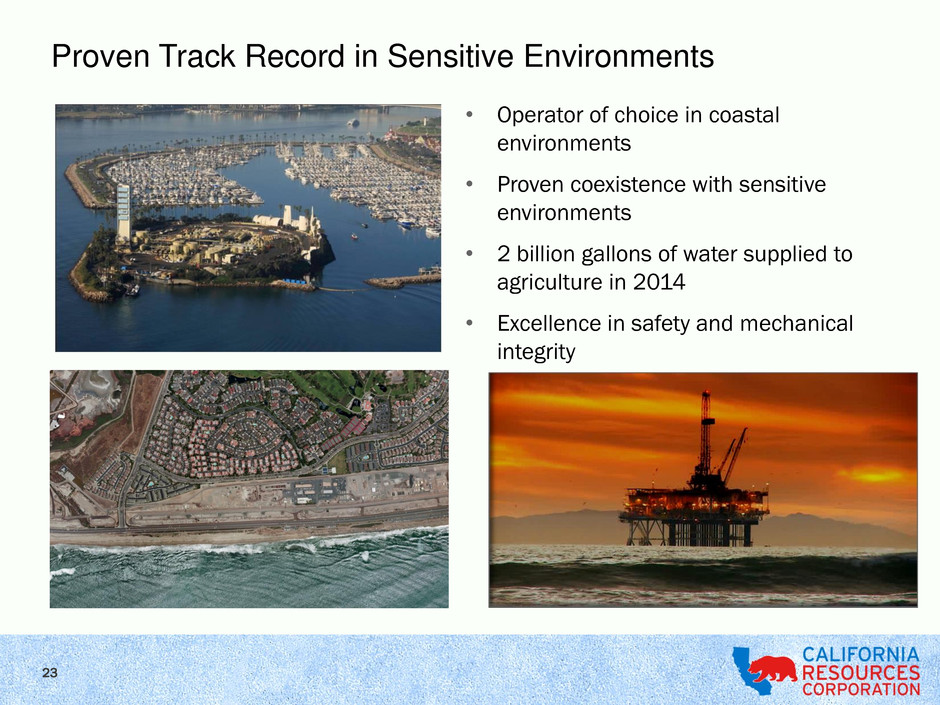
Proven Track Record in Sensitive Environments • Operator of choice in coastal environments • Proven coexistence with sensitive environments • 2 billion gallons of water supplied to agriculture in 2014 • Excellence in safety and mechanical integrity 23

• World-class asset base with diverse and rich resources. • Capacity for significant production growth at higher prices as we develop high-return, lower-risk development opportunities. • Committed to capital budgets that live within our cash flows. • As we bring our capital structure in line with today’s prices, we’re considering a wide variety of options to de-leverage. • Legacy of safe production and commitment to regulatory and community outreach in California. Well Positioned for Growth in Recovery 24
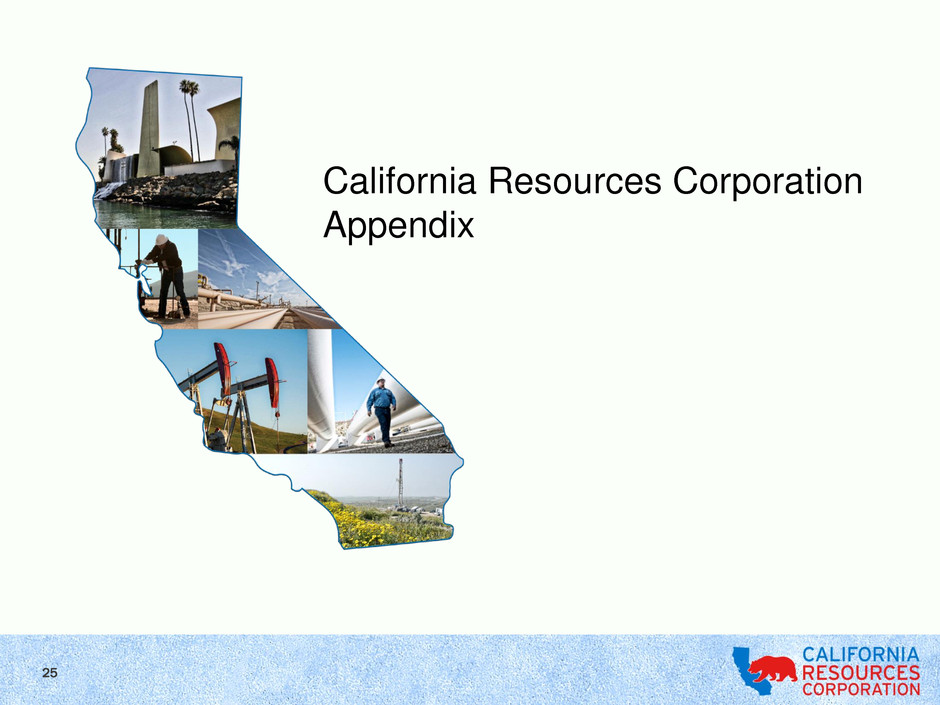
California Resources Corporation Appendix 25
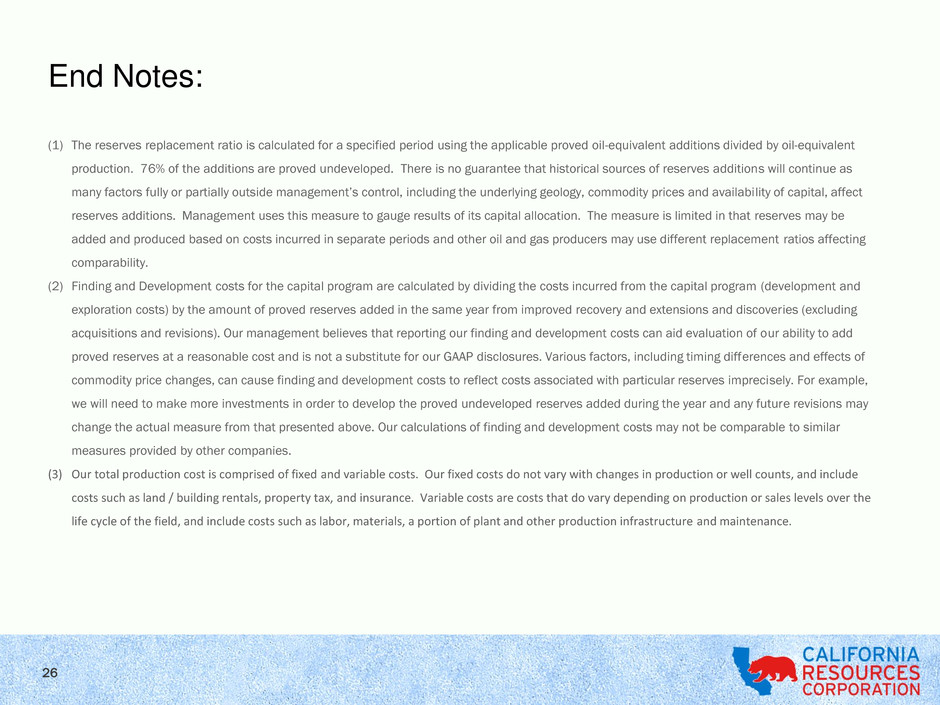
End Notes: (1) The reserves replacement ratio is calculated for a specified period using the applicable proved oil-equivalent additions divided by oil-equivalent production. 76% of the additions are proved undeveloped. There is no guarantee that historical sources of reserves additions will continue as many factors fully or partially outside management’s control, including the underlying geology, commodity prices and availability of capital, affect reserves additions. Management uses this measure to gauge results of its capital allocation. The measure is limited in that reserves may be added and produced based on costs incurred in separate periods and other oil and gas producers may use different replacement ratios affecting comparability. (2) Finding and Development costs for the capital program are calculated by dividing the costs incurred from the capital program (development and exploration costs) by the amount of proved reserves added in the same year from improved recovery and extensions and discoveries (excluding acquisitions and revisions). Our management believes that reporting our finding and development costs can aid evaluation of our ability to add proved reserves at a reasonable cost and is not a substitute for our GAAP disclosures. Various factors, including timing differences and effects of commodity price changes, can cause finding and development costs to reflect costs associated with particular reserves imprecisely. For example, we will need to make more investments in order to develop the proved undeveloped reserves added during the year and any future revisions may change the actual measure from that presented above. Our calculations of finding and development costs may not be comparable to similar measures provided by other companies. (3) Our total production cost is comprised of fixed and variable costs. Our fixed costs do not vary with changes in production or well counts, and include costs such as land / building rentals, property tax, and insurance. Variable costs are costs that do vary depending on production or sales levels over the life cycle of the field, and include costs such as labor, materials, a portion of plant and other production infrastructure and maintenance. 26
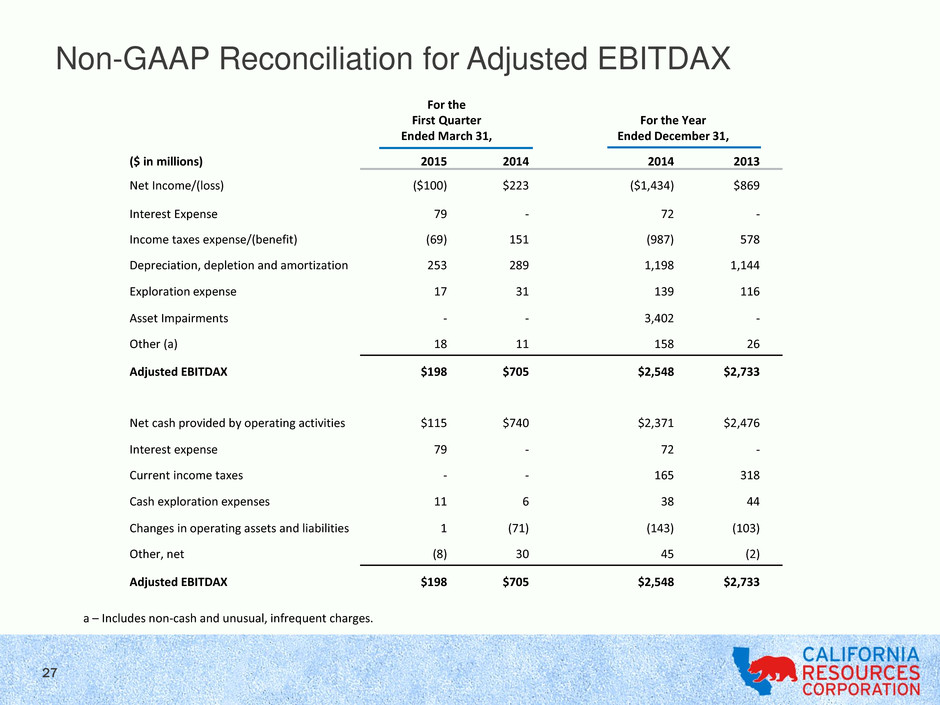
Non-GAAP Reconciliation for Adjusted EBITDAX For the First Quarter Ended March 31, For the Year Ended December 31, ($ in millions) 2015 2014 2014 2013 Net Income/(loss) ($100) $223 ($1,434) $869 Interest Expense 79 - 72 - Income taxes expense/(benefit) (69) 151 (987) 578 Depreciation, depletion and amortization 253 289 1,198 1,144 Exploration expense 17 31 139 116 Asset Impairments - - 3,402 - Other (a) 18 11 158 26 Adjusted EBITDAX $198 $705 $2,548 $2,733 Net cash provided by operating activities $115 $740 $2,371 $2,476 Interest expense 79 - 72 - Current income taxes - - 165 318 Cash exploration expenses 11 6 38 44 Changes in operating assets and liabilities 1 (71) (143) (103) Other, net (8) 30 45 (2) Adjusted EBITDAX $198 $705 $2,548 $2,733 a – Includes non-cash and unusual, infrequent charges. 27
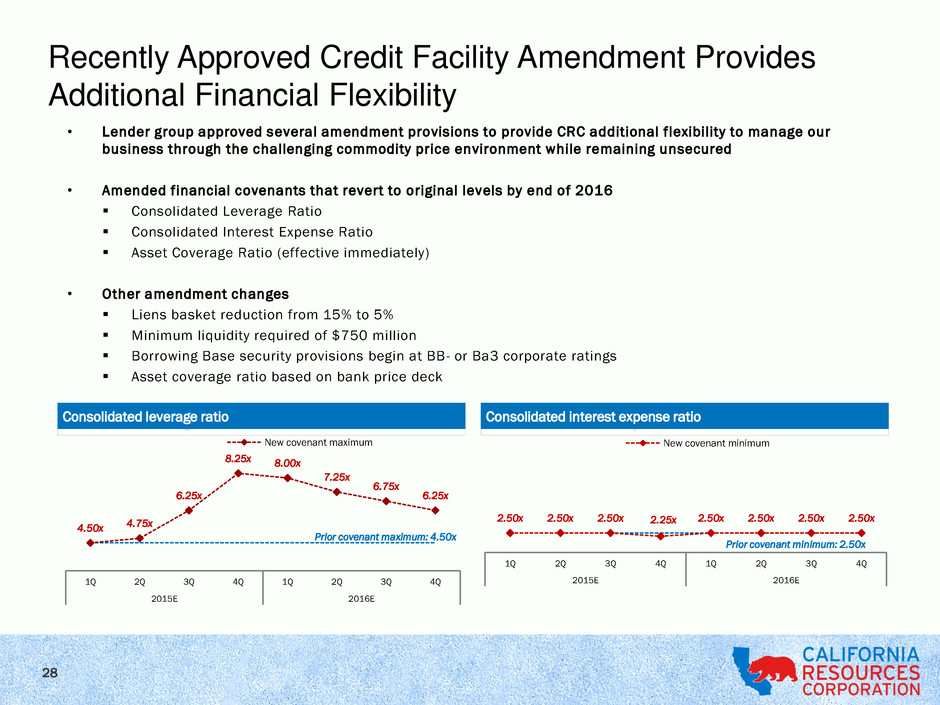
• Lender group approved several amendment provisions to provide CRC additional flexibility to manage our business through the challenging commodity price environment while remaining unsecured • Amended financial covenants that revert to original levels by end of 2016 Consolidated Leverage Ratio Consolidated Interest Expense Ratio Asset Coverage Ratio (effective immediately) • Other amendment changes Liens basket reduction from 15% to 5% Minimum liquidity required of $750 million Borrowing Base security provisions begin at BB- or Ba3 corporate ratings Asset coverage ratio based on bank price deck Recently Approved Credit Facility Amendment Provides Additional Financial Flexibility Consolidated leverage ratio Consolidated interest expense ratio 4.50x 4.75x 6.25x 8.25x 8.00x 7.25x 6.75x 6.25x 1Q 2Q 3Q 4Q 1Q 2Q 3Q 4Q 2015E 2016E New covenant maximum Prior covenant maximum: 4.50x 2.50x 2.50x 2.50x 2.25x 2.50x 2.50x 2.50x 2.50x 1Q 2Q 3Q 4Q 1Q 2Q 3Q 4Q 2015E 2016E New covenant minimum Prior covenant minimum: 2.50x 28
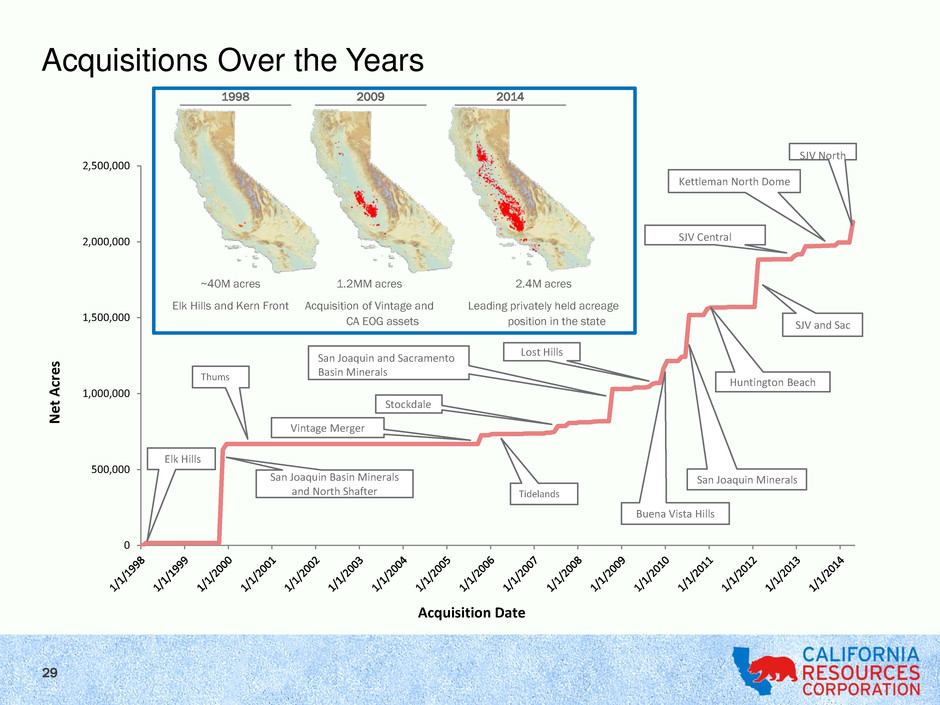
Acquisitions Over the Years 0 500,000 1,000,000 1,500,000 2,000,000 2,500,000 Acquisition Date San Joaquin and Sacramento Basin Minerals San Joaquin MineralsSan Joaquin Basin Minerals and North Shafter SJV North SJV and Sac Stockdale SJV Central Huntington Beach Buena Vista Hills Kettleman North Dome Lost Hills Elk Hills Vintage Merger N et A cr es ~40M acres Elk Hills and Kern Front 1.2MM acres Acquisition of Vintage and CA EOG assets 2.4M acres Leading privately held acreage position in the state 1998 2009 2014 Tidelands Thums 29
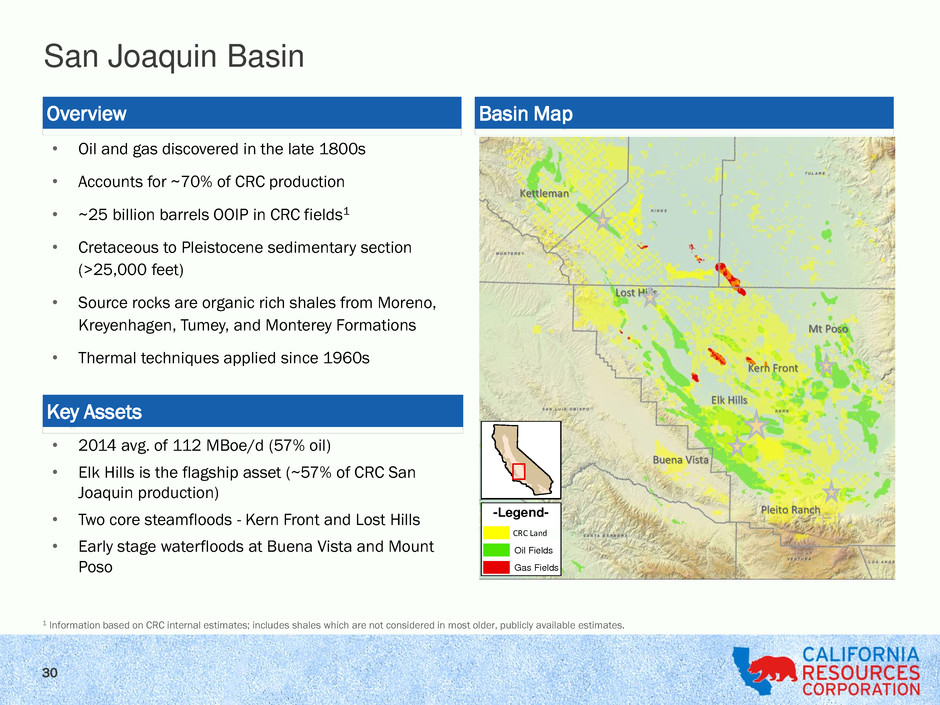
San Joaquin Basin • Oil and gas discovered in the late 1800s • Accounts for ~70% of CRC production • ~25 billion barrels OOIP in CRC fields1 • Cretaceous to Pleistocene sedimentary section (>25,000 feet) • Source rocks are organic rich shales from Moreno, Kreyenhagen, Tumey, and Monterey Formations • Thermal techniques applied since 1960s • 2014 avg. of 112 MBoe/d (57% oil) • Elk Hills is the flagship asset (~57% of CRC San Joaquin production) • Two core steamfloods - Kern Front and Lost Hills • Early stage waterfloods at Buena Vista and Mount Poso Overview Key Assets Basin Map -Legend- Oxy Land Oil Fields Gas Fields Buena Vista Pleito Ranch Elk Hills Kettleman Lost Hills Mt Poso CRC Land Kern Front 1 Information based on CRC internal estimates; includes shales which are not considered in most older, publicly available estimates. 30
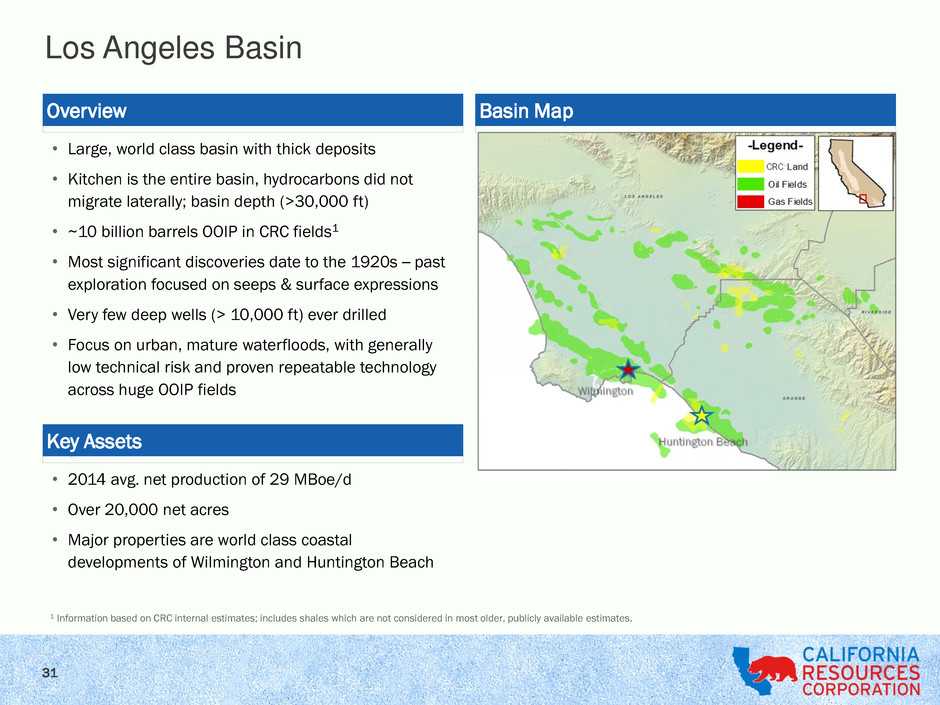
Los Angeles Basin • Large, world class basin with thick deposits • Kitchen is the entire basin, hydrocarbons did not migrate laterally; basin depth (>30,000 ft) • ~10 billion barrels OOIP in CRC fields1 • Most significant discoveries date to the 1920s – past exploration focused on seeps & surface expressions • Very few deep wells (> 10,000 ft) ever drilled • Focus on urban, mature waterfloods, with generally low technical risk and proven repeatable technology across huge OOIP fields • 2014 avg. net production of 29 MBoe/d • Over 20,000 net acres • Major properties are world class coastal developments of Wilmington and Huntington Beach Overview Key Assets Basin Map 31 1 Information based on CRC internal estimates; includes shales which are not considered in most older, publicly available estimates.

Sacramento Basin • Exploration started in 1918 and focused on seeps and topographic highs. In the 1970s the use of multifold 2D seismic led to largest discoveries • Cretaceous Starkey, Winters, Forbes, Kione, and the Eocene Domengine sands • Most current production is less than 10,000 feet • 3D seismic surveys in mid 1990s helped define trapping mechanisms and reservoir geometries • CRC has 53 active fields (consolidated into 35 operating areas where we have facilities) • 2014 average net production of 9 MBoe/d (100% dry gas) • Produce 85% of basin gas with synergies of scale • Price and volume opportunity Overview Key Assets Basin Map 32
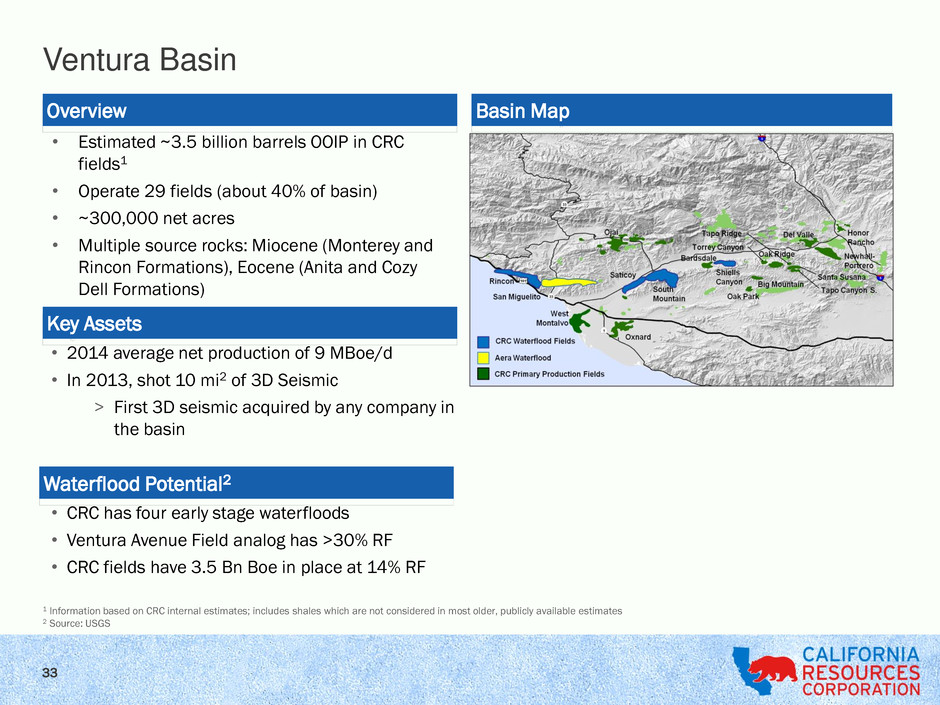
Ventura Basin • Estimated ~3.5 billion barrels OOIP in CRC fields1 • Operate 29 fields (about 40% of basin) • ~300,000 net acres • Multiple source rocks: Miocene (Monterey and Rincon Formations), Eocene (Anita and Cozy Dell Formations) • 2014 average net production of 9 MBoe/d • In 2013, shot 10 mi2 of 3D Seismic > First 3D seismic acquired by any company in the basin Overview Key Assets Basin Map • CRC has four early stage waterfloods • Ventura Avenue Field analog has >30% RF • CRC fields have 3.5 Bn Boe in place at 14% RF Waterflood Potential2 1 Information based on CRC internal estimates; includes shales which are not considered in most older, publicly available estimates 2 Source: USGS 33
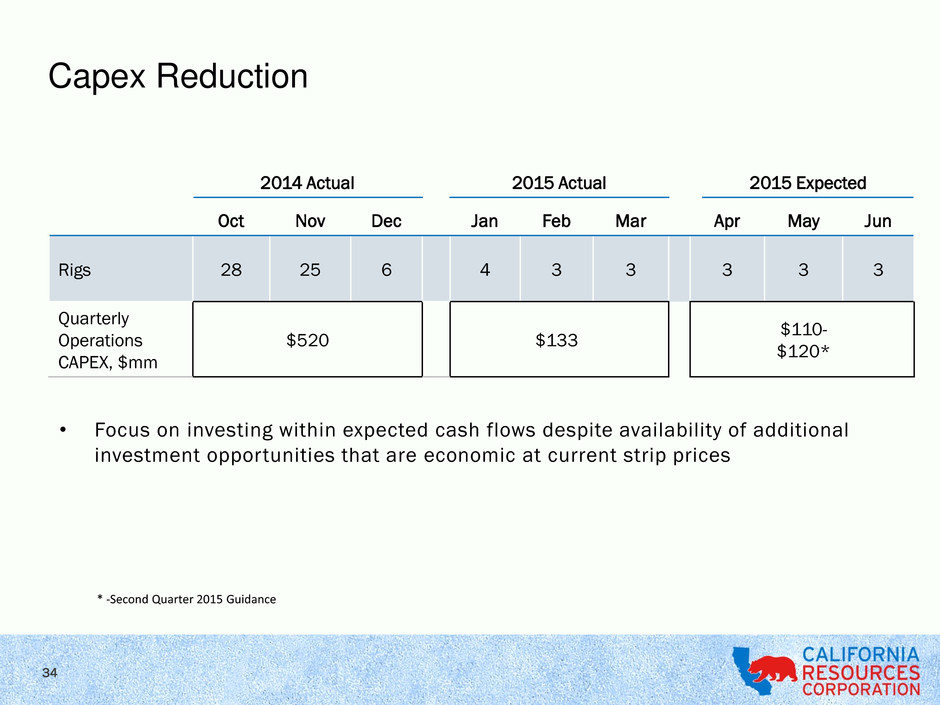
Capex Reduction 2014 Actual 2015 Actual 2015 Expected Oct Nov Dec Jan Feb Mar Apr May Jun Rigs 28 25 6 4 3 3 3 3 3 Quarterly Operations CAPEX, $mm $520 $133 $110- $120* • Focus on investing within expected cash flows despite availability of additional investment opportunities that are economic at current strip prices * -Second Quarter 2015 Guidance 34
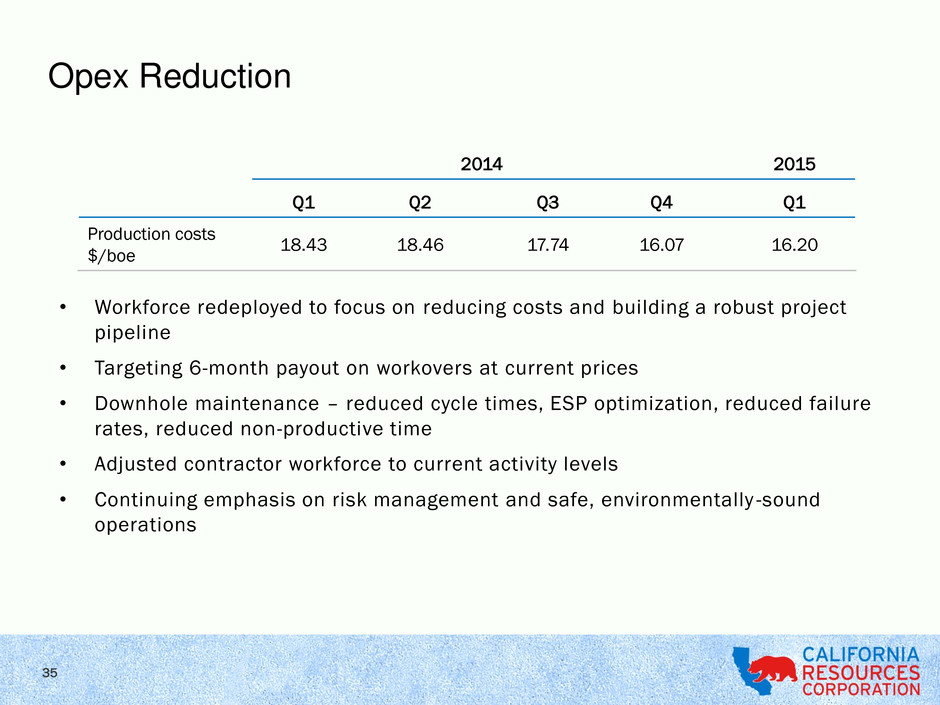
Opex Reduction 2014 2015 Q1 Q2 Q3 Q4 Q1 Production costs $/boe 18.43 18.46 17.74 16.07 16.20 • Workforce redeployed to focus on reducing costs and building a robust project pipeline • Targeting 6-month payout on workovers at current prices • Downhole maintenance – reduced cycle times, ESP optimization, reduced failure rates, reduced non-productive time • Adjusted contractor workforce to current activity levels • Continuing emphasis on risk management and safe, environmentally -sound operations 35
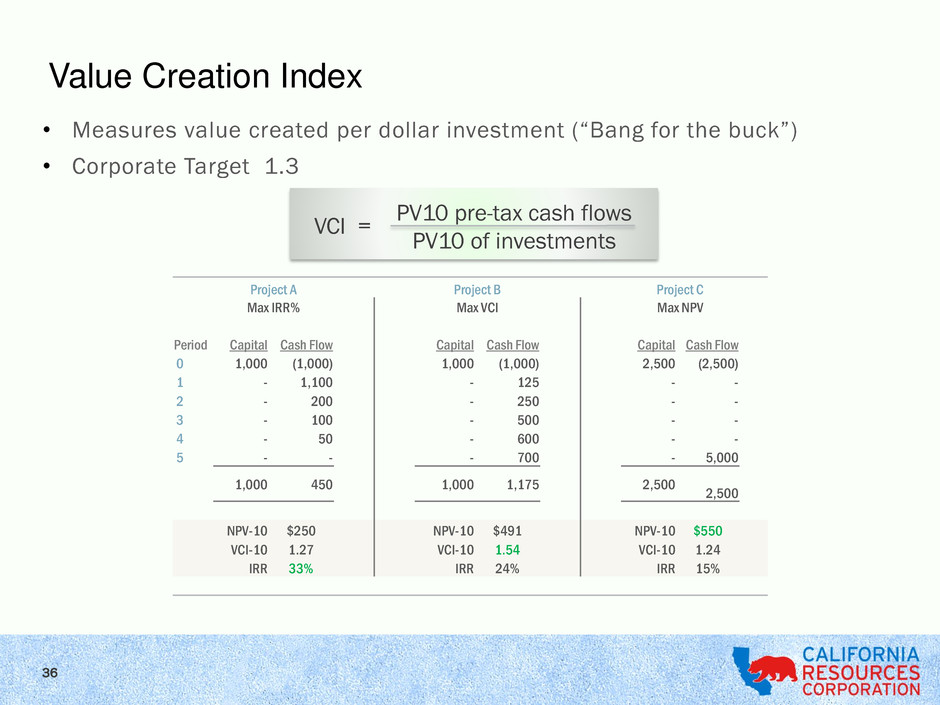
• Measures value created per dollar investment (“Bang for the buck”) • Corporate Target 1.3 PV10 pre-tax cash flows PV10 of investments VCI = Project A Project B Project C Max IRR% Max VCI Max NPV Period Capital Cash Flow Capital Cash Flow Capital Cash Flow 0 1,000 (1,000) 1,000 (1,000) 2,500 (2,500) 1 - 1,100 - 125 - - 2 - 200 - 250 - - 3 - 100 - 500 - - 4 - 50 - 600 - - 5 - - - 700 - 5,000 1,000 450 1,000 1,175 2,500 2,500 NPV-10 $250 NPV-10 $491 NPV-10 $550 VCI-10 1.27 VCI-10 1.54 VCI-10 1.24 IRR 33% IRR 24% IRR 15% 36 Value Creation Index
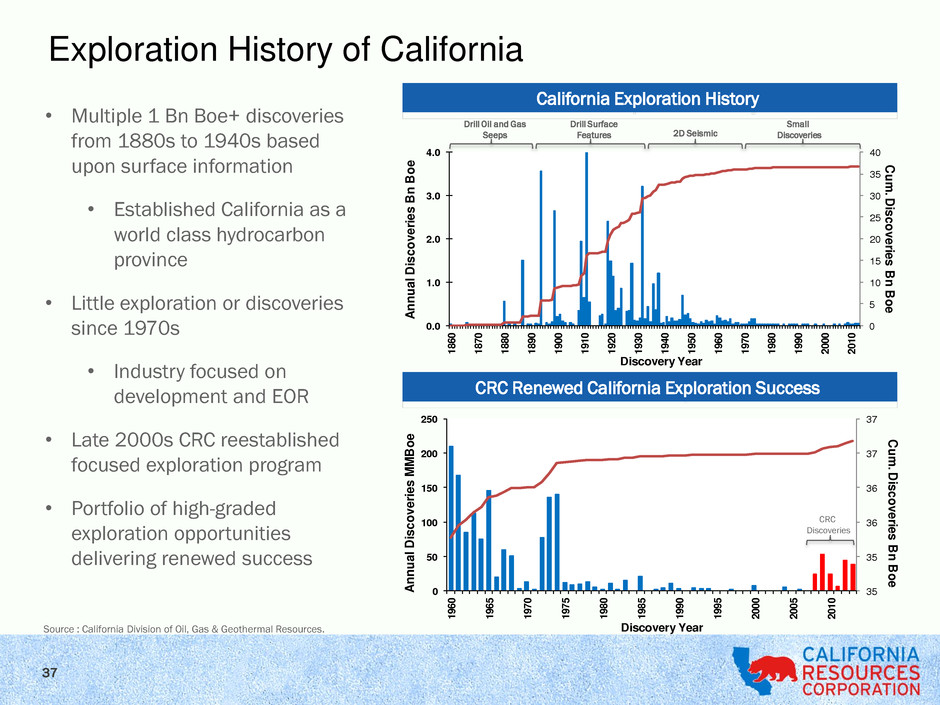
37 Exploration History of California 0 5 10 15 20 25 30 35 40 0.0 1.0 2.0 3.0 4.0 18 60 18 70 18 80 18 90 19 00 19 10 19 20 19 30 19 40 19 50 19 60 19 70 19 80 19 90 20 00 20 10 An nu al Di sc ov eri es B n B oe Discovery Year Cum. Discoveries Bn Boe• Multiple 1 Bn Boe+ discoveries from 1880s to 1940s based upon surface information • Established California as a world class hydrocarbon province • Little exploration or discoveries since 1970s • Industry focused on development and EOR • Late 2000s CRC reestablished focused exploration program • Portfolio of high-graded exploration opportunities delivering renewed success 35 35 36 36 37 37 0 50 100 150 200 250 19 60 19 65 19 70 19 75 19 80 19 85 19 90 19 95 20 00 20 05 20 10 An nu al Di sc ov eri es M MB oe Discovery Year Cum. Discoveries Bn Boe CRC Renewed California Exploration Success California Exploration History Drill Oil and Gas Seeps Drill Surface Features 2D Seismic Small Discoveries CRC Discoveries Source : California Division of Oil, Gas & Geothermal Resources.

Shale Geological Overview Major U.S. Shale PlaysCalifornia Unconventional Potential 0 GR 150 0 GR 150 0 GR 150 0 GR 150 0 GR 150 0 GR 150 3,000 2,000 1,000 Kreyenhagen Productive interval Target interval Moreno Bakken Barnett Eagle Ford N A B C D PG • Successful in upper Monterey using precise development approach • Expanding efforts into lower Monterey and other shales Play Depth (ft) Thickness (gross ft) Porosity (%) Permeability (mD) Total Organic Carbon (%) Upper Monterey1 3,500' – 12,000' 250' – 3,500' 5 – 30 <0.0001 – 2 1 – 12 Lower Monterey1 9,000' – 16,000' 200' – 500' 5 – 12 <0.001 – 0.05 2 – 18 Kreyenhagen1 8,000' – 16,000' 200' – 350' 5 – 15 <0.001 – 0.1 1 – 6 Moreno1 8,000' – 16,000' 200' – 300' 5 – 10 <0.001 – 0.1 2 – 6 Bakken 3,000' – 11,000' 6' – 145' 2 – 12 0.05 8 – 21 Barnett 5,400' – 9,500' 100' – 500' 4.0 – 9.6 <0.0001 – 0.1 4 – 8 Eagle Ford 5,000' – 12,000' 100' – 250' 3.4 – 14.6 0.13 2 – 9 CRC Current Production CRC Areas of Future Development 1Reservoir characteristics were internally generated based on regional 2D seismic data, 3D seismic data, open hole and mud log data, cores and other reservoir engineering data. 38
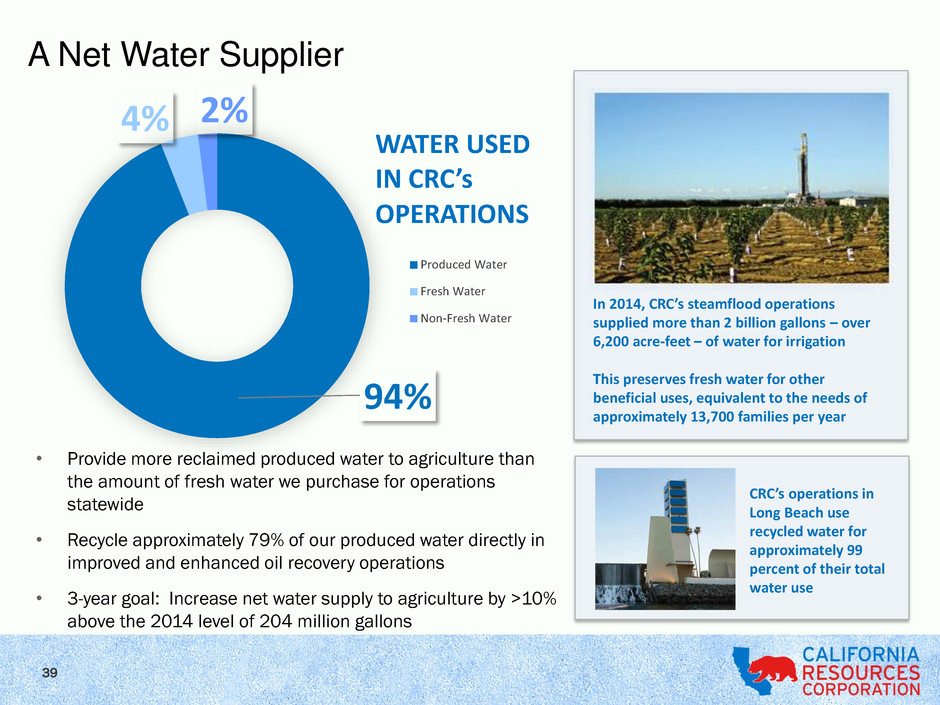
A Net Water Supplier • Provide more reclaimed produced water to agriculture than the amount of fresh water we purchase for operations statewide • Recycle approximately 79% of our produced water directly in improved and enhanced oil recovery operations • 3-year goal: Increase net water supply to agriculture by >10% above the 2014 level of 204 million gallons 94% 4% 2% WATER USED IN CRC’s OPERATIONS Produced Water Fresh Water Non-Fresh Water In 2014, CRC’s steamflood operations supplied more than 2 billion gallons – over 6,200 acre-feet – of water for irrigation This preserves fresh water for other beneficial uses, equivalent to the needs of approximately 13,700 families per year 39 CRC’s operations in Long Beach use recycled water for approximately 99 percent of their total water use

Non-GAAP Reconciliation for PV-10 ($ in millions) At December 31, 2014 PV-10 $16,091 Present value of future income taxes discounted at 10% (5,263) Standardized Measure of Discounted Future Net Cash Flows $10,828 PV-10 is a non-GAAP financial measure and represents the year-end present value of estimated future cash inflows from proved oil an natural gas reserves, less future development and production costs, discounted at 10% per annum to reflect the timing of future cash flows and using SEC prescribed pricing assumptions for the period. PV-10 differs from Standardized Measure because Standardized Measure includes the effects of future income taxes on future net cash flows. Neither PV-10 nor Standardized Measure should be construed as the fair value of our oil and natural gas reserves. PV-10 and Standardized Measure are used by the industry and by our management as an asset value measure to compare against our past reserve bases and the reserve bases of other business entities because the pricing, cost environment and discount assumptions are prescribed by the SEC and are comparable. PV-10 further facilitates the comparisons to other companies as it is not dependent on the tax paying status of the entity. 40
